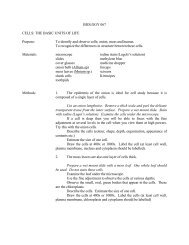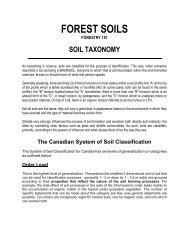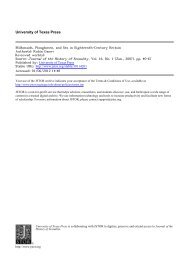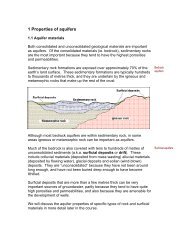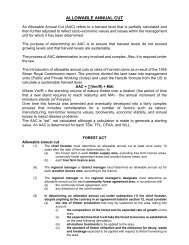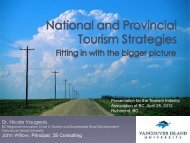Assignment #3: Plate Tectonics - web.mala.bc.ca - Vancouver Island ...
Assignment #3: Plate Tectonics - web.mala.bc.ca - Vancouver Island ...
Assignment #3: Plate Tectonics - web.mala.bc.ca - Vancouver Island ...
Create successful ePaper yourself
Turn your PDF publications into a flip-book with our unique Google optimized e-Paper software.
Part 2, Sea-floor Spreading:<br />
Introduction:<br />
Geology 111 and Geol 111A – Understanding Planet Earth<br />
Understanding the patterns of sea-floor magnetism:<br />
A magnetometer is an instrument that is used to measure very small spatial variations in the<br />
intensity of the earth’s magnetic field. Magnetometers <strong>ca</strong>n be moved around on land (usually by a<br />
person on foot), in the air (towed beneath an aircraft) or at sea (towed behind a ship). Studies of<br />
magnetic variations are useful in geologi<strong>ca</strong>l mapping and exploration for minerals be<strong>ca</strong>use they<br />
provide general information about variations in rock types (e.g. granite versus basalt), and about<br />
the presence of rocks that have signifi<strong>ca</strong>ntly more magnetic minerals than other rocks (e.g. iron<br />
ores with magnetite).<br />
During WWII, naval ships accompanying supply convoys crossing the Atlantic Ocean towed<br />
sensitive magnetometers behind. These magnetometers were looking for submarines (a large<br />
metal body <strong>ca</strong>pable of deflecting the Earth’s magnetic field lo<strong>ca</strong>lly). The operators of the<br />
magnetometers found strange patterns of magnetic field reversals as they traversed the Atlantic.<br />
In the mid-1950s the U.S. Office of Naval Research undertook a systematic oceanographic<br />
survey of an area off the west coast. After much persuasion, they agreed to a request from the<br />
Scripps Institute of Oceanography to tow a magnetometer behind the ship. The results of this<br />
survey, which, for the first time, included many precisely lo<strong>ca</strong>ted parallel survey lines, are shown<br />
on Figure 2 below - a confusing, but systematic pattern of contrasting strips of positive<br />
magnetism (black areas) and negative magnetism (white areas).<br />
In the following years similar surveys were done in other areas - with similar results. However,<br />
the origin of the patterns remained a mystery until 1963 when a solution was proposed by a<br />
Cambridge graduate student (Fred Vine) and his thesis advisor (Drummond Matthews), and<br />
(independently) by a Geologi<strong>ca</strong>l Survey of Canada Geologist (Lawrence Morely).<br />
Vine, Matthews and Morely (VMM) suggested that the patterns could be related to the creation<br />
of new oceanic crust at a spreading centre, and to the periodic reversals of the earth's magnetic<br />
field. The idea is that as new basaltic crust is created its minerals (particularly magnetite) become<br />
magnetized in alignment with the existing magnetic field of the earth. Rock formed during a<br />
period of normal magnetism will give a positive magnetic anomaly be<strong>ca</strong>use the rock has the same<br />
polarity as the earth’s existing magnetic field, while rock formed during a period of reverse<br />
magnetism will give a negative magnetic anomaly. The stripes on the ocean floor, it was<br />
suggested, represent different ages of oceanic basaltic rock, which have been pushed away to<br />
either side of a spreading centre and replaced by younger basaltic rock.<br />
To begin with the VMM hypothesis was largely ignored, firstly be<strong>ca</strong>use in the early 1960's the<br />
idea of sea-floor spreading itself was not well accepted, secondly be<strong>ca</strong>use the chronology of<br />
magnetic-field reversals was not well known, and thirdly be<strong>ca</strong>use there was not enough sea-floor<br />
magnetic data to test the idea. Much more data be<strong>ca</strong>me available within a few years, and once<br />
others had a chance to verify the phenomenon for them selves the hypothesis be<strong>ca</strong>me widely<br />
accepted, and in fact played a crucial role in the general acceptance of continental drift and plate<br />
tectonics a few years later.<br />
Earth Science Department <strong>Vancouver</strong> <strong>Island</strong> University 4



